[Contains images which are NSFW but safe for Japanese children everywhere. All images read from right to left and are taken from the Chinese reprinting of The Left Hand of God, The Right Hand of the Devil]
“Whatever is fitted in any sort to excite the ideas of pain and danger, that is to say, whatever is in any sort terrible, or is conversant about terrible objects, or operates in a manner analogous to terror, is a source of the sublime; that is, it is productive of the strongest emotion which the mind is capable of feeling. I say the strongest emotion, because I am satisfied the ideas of pain are much more powerful than those which enter on the part of pleasure.”
It is probably safe to assume that the success of the comics of Umezu Kazuo (if mostly in Japan) is predicated on the extreme violence, the lurid monsters, and the somewhat peculiar situations he gets his young characters into.
But underpinning all of this is Umezu’s deep understanding of childhood uncertainty; a child’s nagging suspicion of the “big people” who govern their world: the teacher who deserves only to be strangled…
…the loathsome neighbor who waits ready to poison and defile innocence.
Manga like The Drifting Classroom present adults as diabolical and feeble minded beasts. If the hero’s mother seems homely and pleasant enough, she remains otherwise distant and separate, like some countermanding and occasionally comforting God; only present in the mind but never in the flesh. These adults cannot be relied upon, and we often find them debilitated and trussed up in bed. In The Left Hand of God, The Right Hand of the Devil, for instance, the protagonist’s parents lie injured and exposed to their children; together yet withheld from copulation:
This short but vicious part of Umezu’s oeuvre is persistent in its suggestions that parents are absolute savages; far more to be feared than the demons lurking beneath a tall, oppressive bed; or behind a fence hoping to pull unsuspecting children like callow fish from the pavement.
In the first chapter of volume 4 of The Left Hand of God, The Right Hand of the Devil, a well-dressed girl rejects a ratty doll left on the pavement as bait and is allowed to pass unharmed by a lurking psychopath. A younger and less sophisticated girl shows more sympathy and retrieves the doll, cradling it with tenderness and affection. Her slow, gruesome dispatch at the end of a murderer’s hook is quite inevitable.
If there is a lesson to be learnt from these opening scenes, it may be that only those who cast aside childish things will be spared, the earnestly naive are annihilated or served up as dinner:
The children in Umezu’s stories are always on the edge of fear; that fear of aberrant birth and of unnatural parenting despite all evidence to the contrary — a dividend of that familiar combination of parental love and torment. These manga were once bought with money provided by their young readers’ parents; the very humans presented as being on the edge of reason in Umezu’s manga; here questioned indirectly for allowing their children access to the material in question.
The theme of parental neglect is reiterated as we progress through this fourth volume. An episode where children are force fed blood-soaked cupcakes may seem like a morality tale on the subject of greed, but this distant memory of Hansel and Gretel is also a rebuke to parents for presenting their children with “poisoned fruit”. This attempt by Umezu to associate death with sweetness is a faint echo of the modern Japanese version of the water torture — the dripping leftovers shoveled down the victims’ tender throats till their stomachs bulge and their intestines sliced open to reveal the products of their engorgement.
Their heads are then severed and stored as trophies — all of this deadly reminiscent of the Japanese army during their trek down and across China and Southeast Asia.
[World War II Cannibalism from Orochi Vol. 5]
Whether all this is the product of a feverish mind or of careful planning is hard to ascertain. The lighthearted manner in which Umezu carries himself in interviews acts to deflect any criticism based upon sexual innuendo or base perversion. Sometimes though, the evidence simply cannot be ignored.
Umezu’s foray into the hypersexualized industry of child idols in the final book of The Left Hand of God, The Right Hand of the Devil has an undeviating perspective on female murder. The common or garden deaths are reserved for the men of his tale. A male medium is crushed by a crane, and the protagonist’s father knocked over the head by a falling rock.
Not so the protagonist’s mother, who is accidentally pierced by a deflected harpoon during the young hero’s attempt to kill the demon possessed girl of the story.
[Freudian lapse: The hero attempts to harpoon the devilish beauty but pierces his mother instead ]
That girl is later seen introducing a hypodermic needle into the belly of a fellow idol and competitor….
…deflowering her competitor with an acrid flow which brings corruption and a swirl of furious inking to her pubis. Here we see her doubling over in pain as she is suffused by a cramping evil; a tainted contraction.
The demon girl’s comeuppance comes as she is ritually pierced with needles even as she is meeting the man of her dreams: both a ritual violation and a premonition of things to come.
When the demon is expelled from the young girl, it decides to inhabit the body of a lab monkey, that primal substitute for man now made intelligent. The drawing which it creates to the amazement of all is a vision of its master, a reflection of the author himself.
Now stripped of all pretense; the grinning apotheosis of Umezu’s views on human action, invention, and manipulation.
Photo of Umezu Kazuo
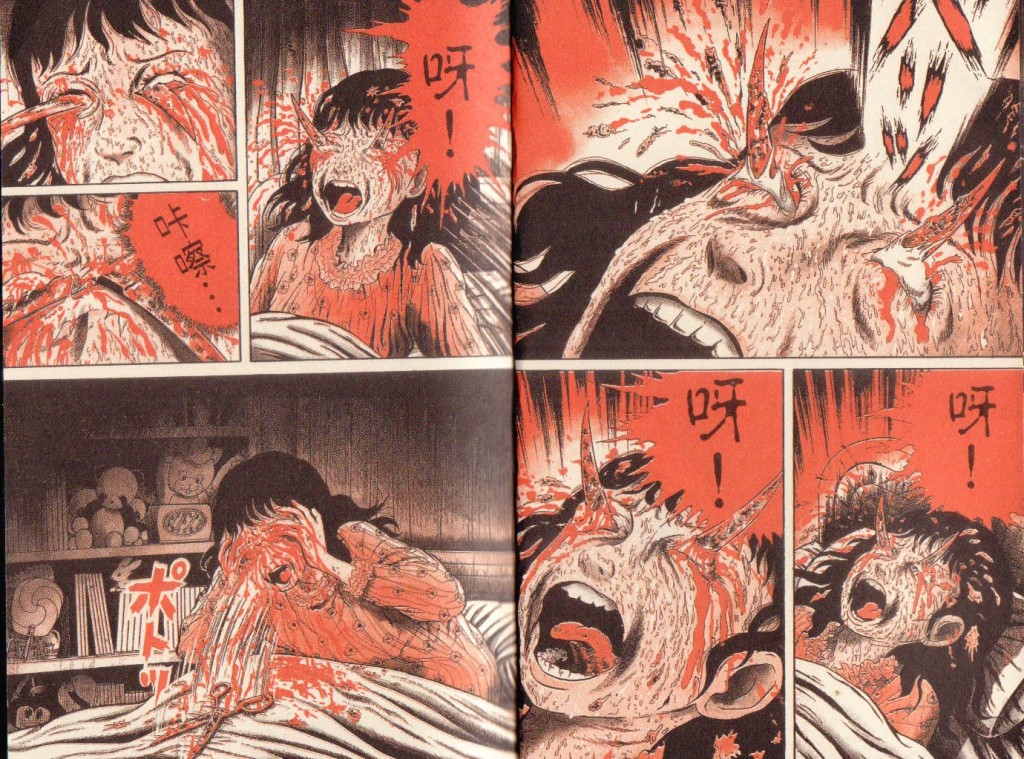
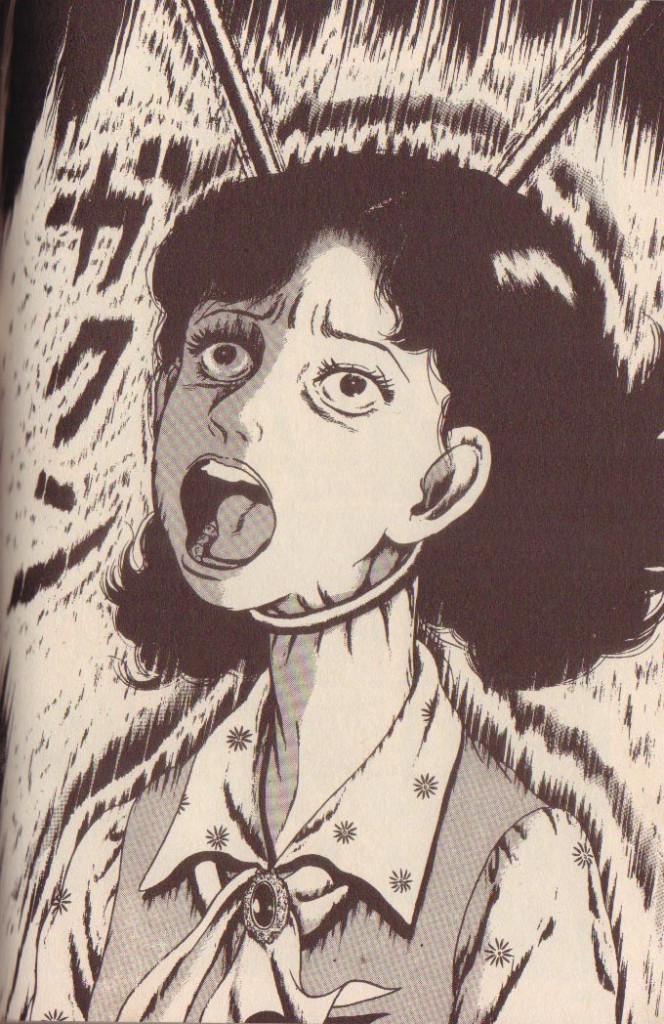
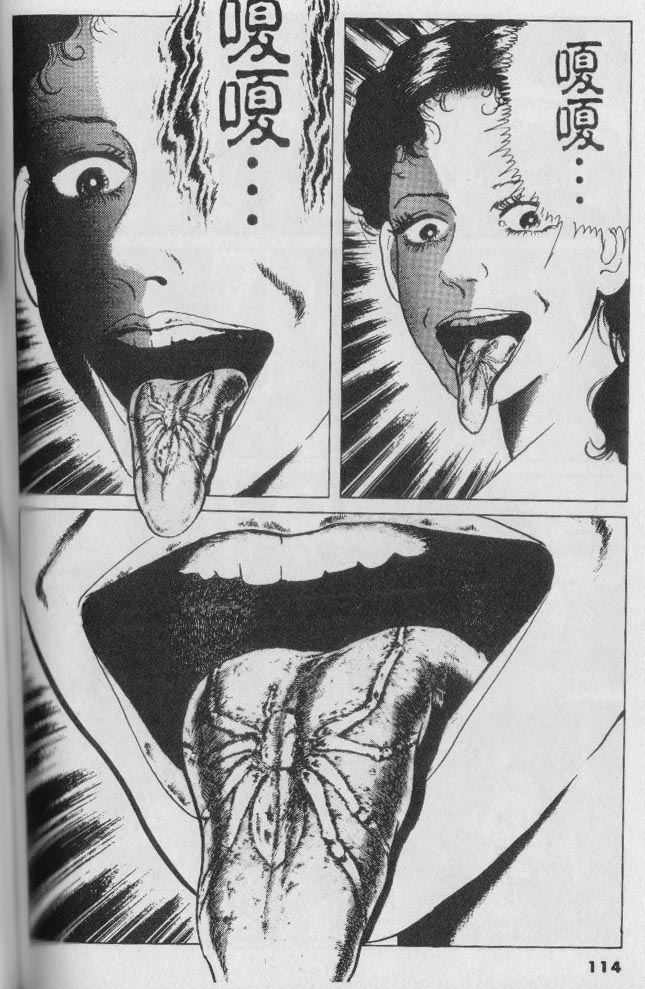
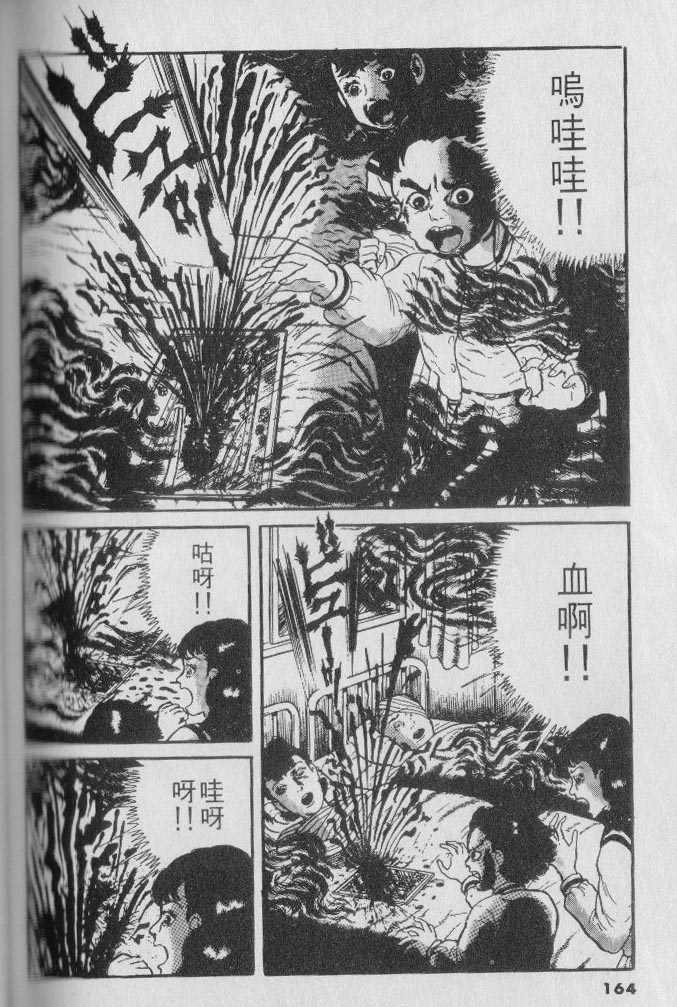

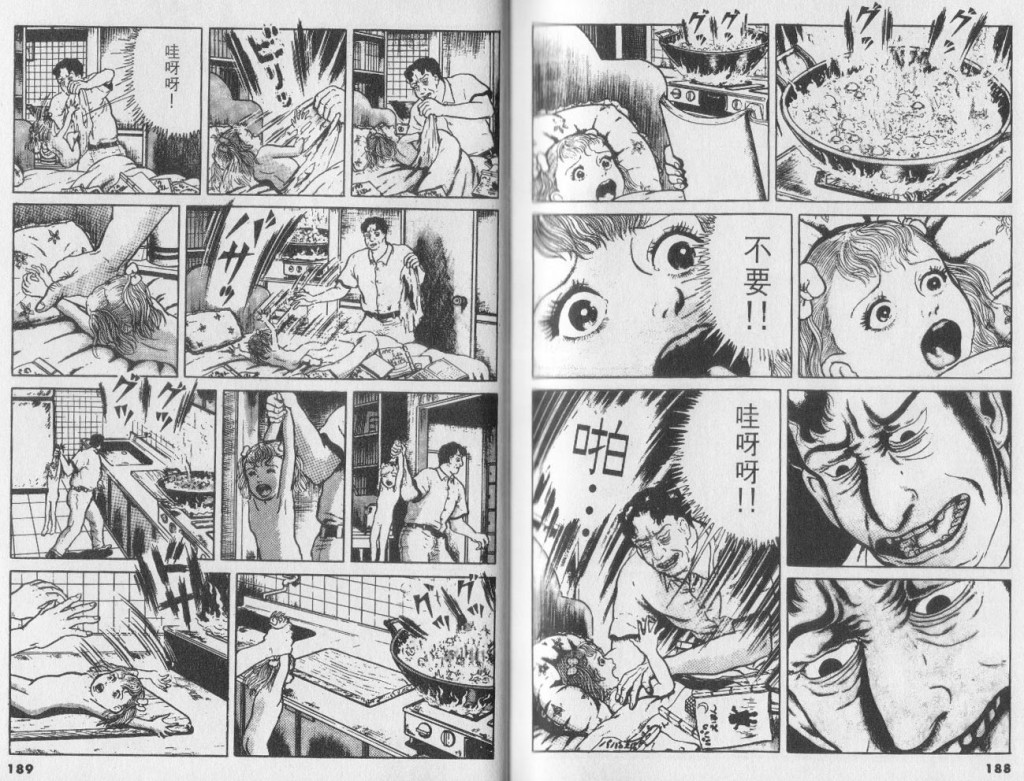
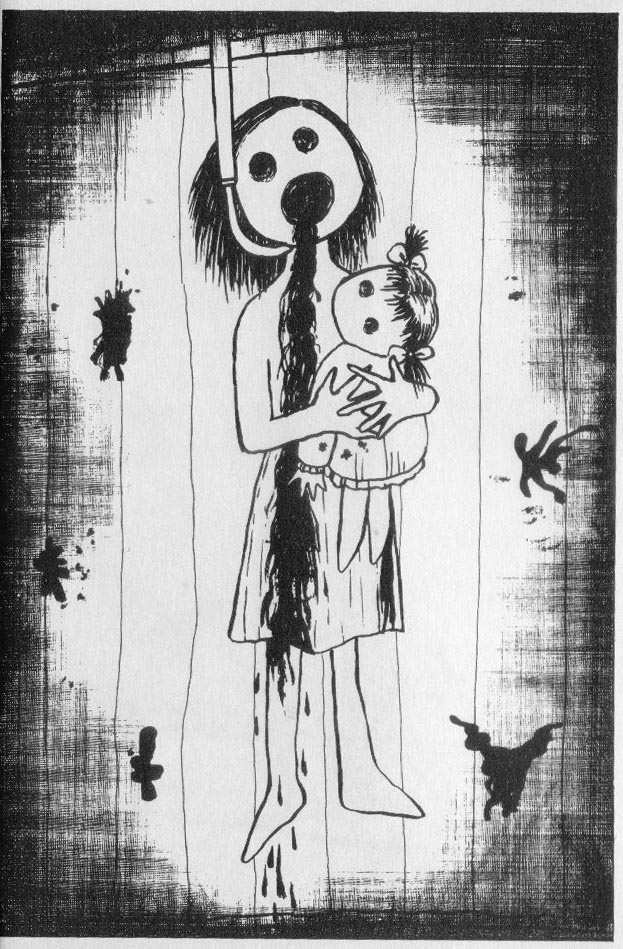
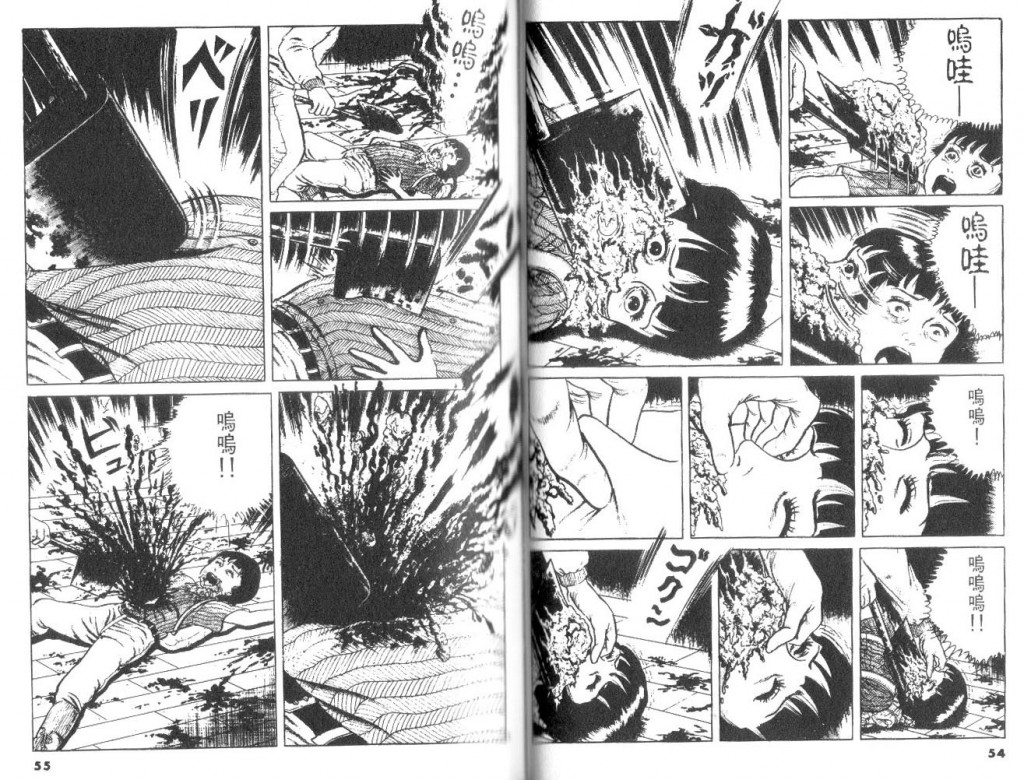
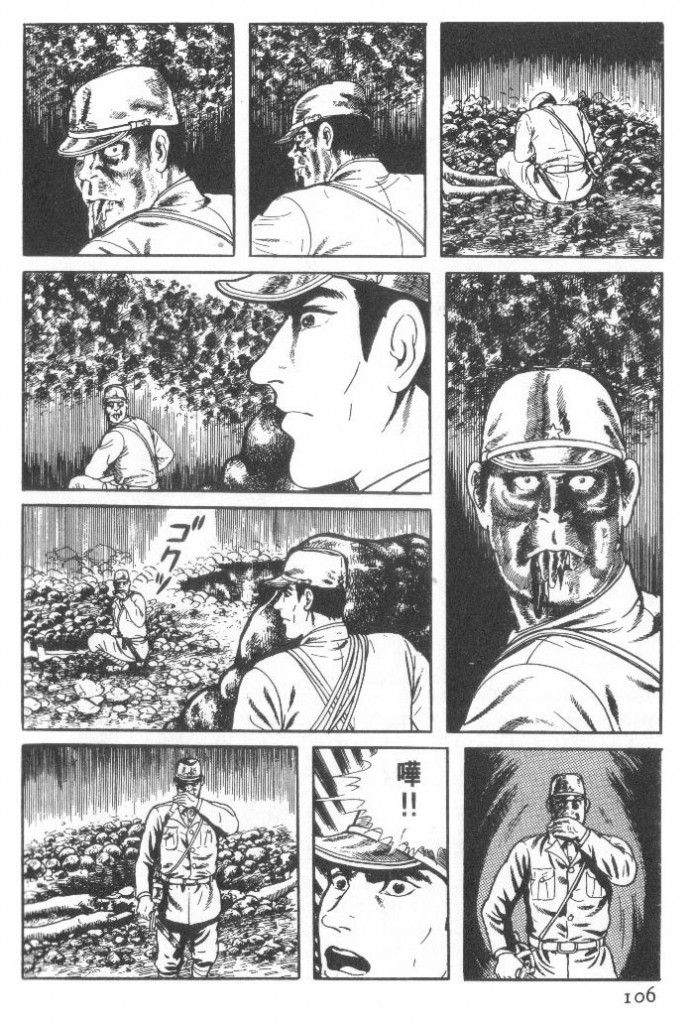
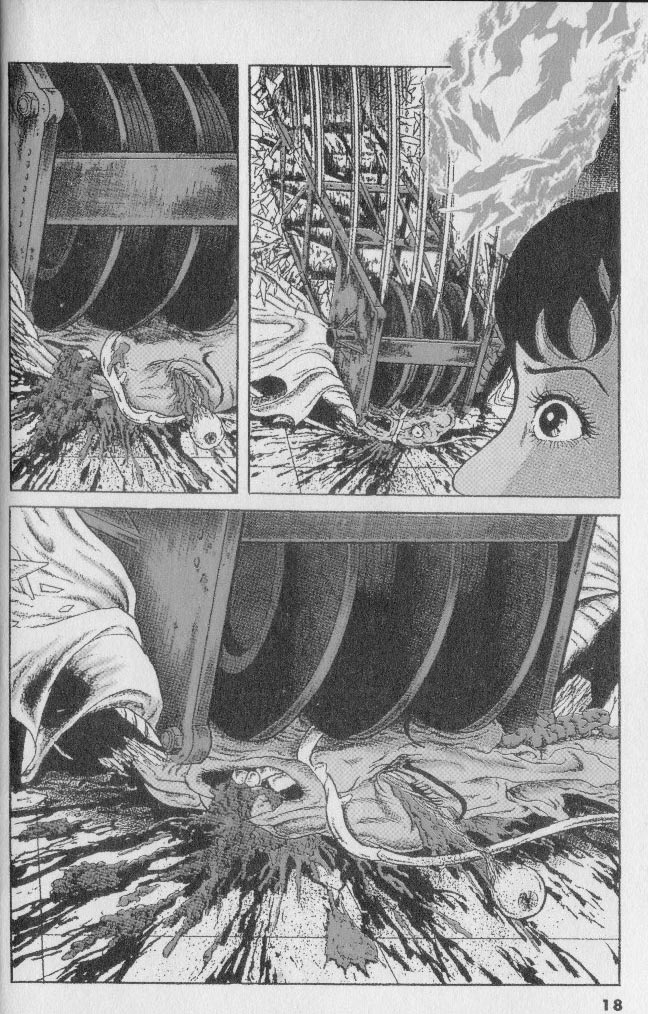

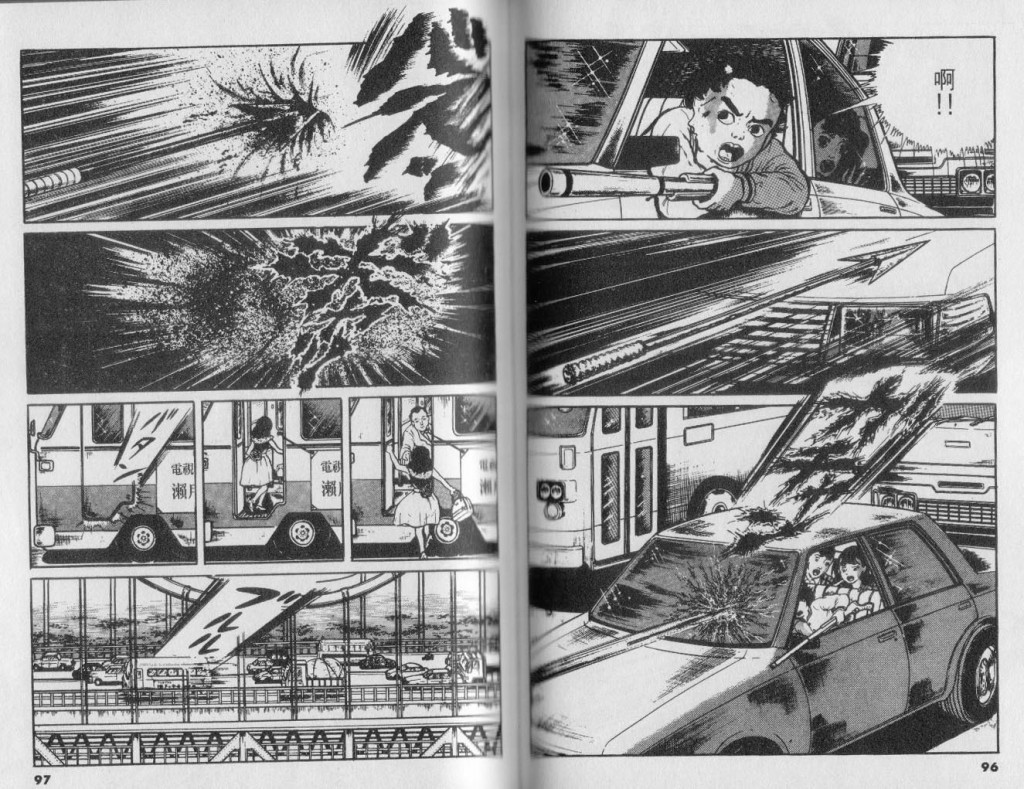
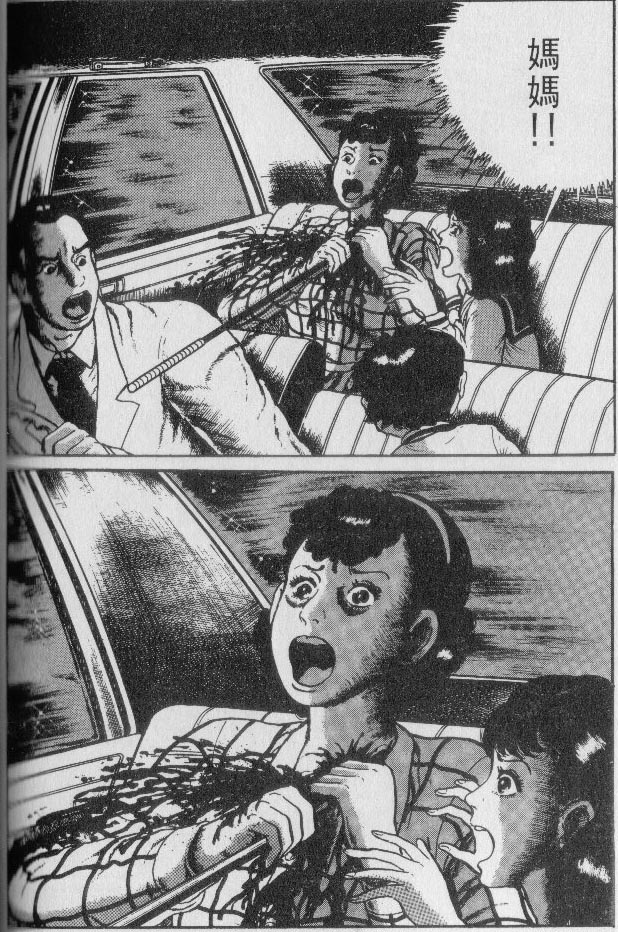
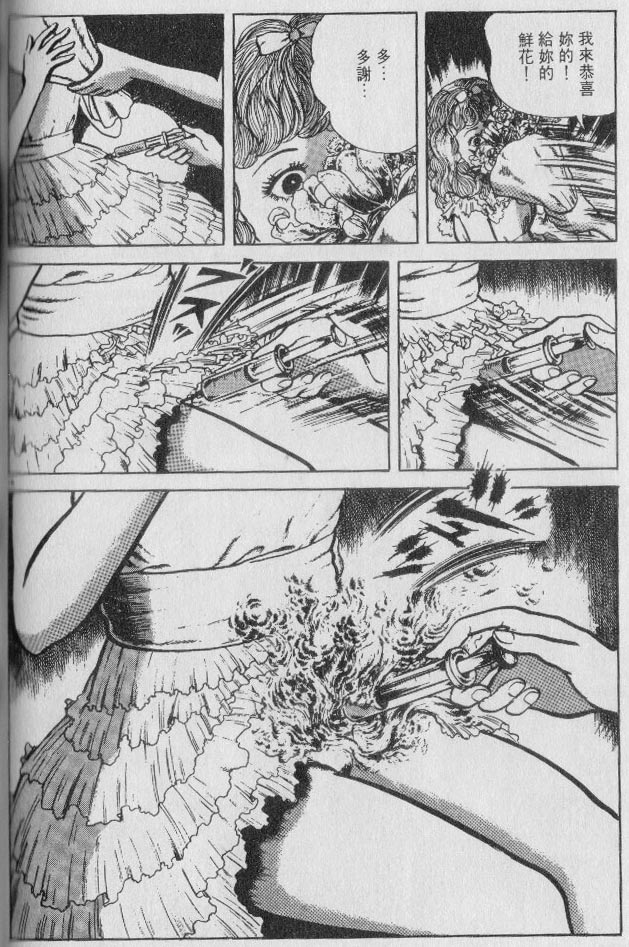

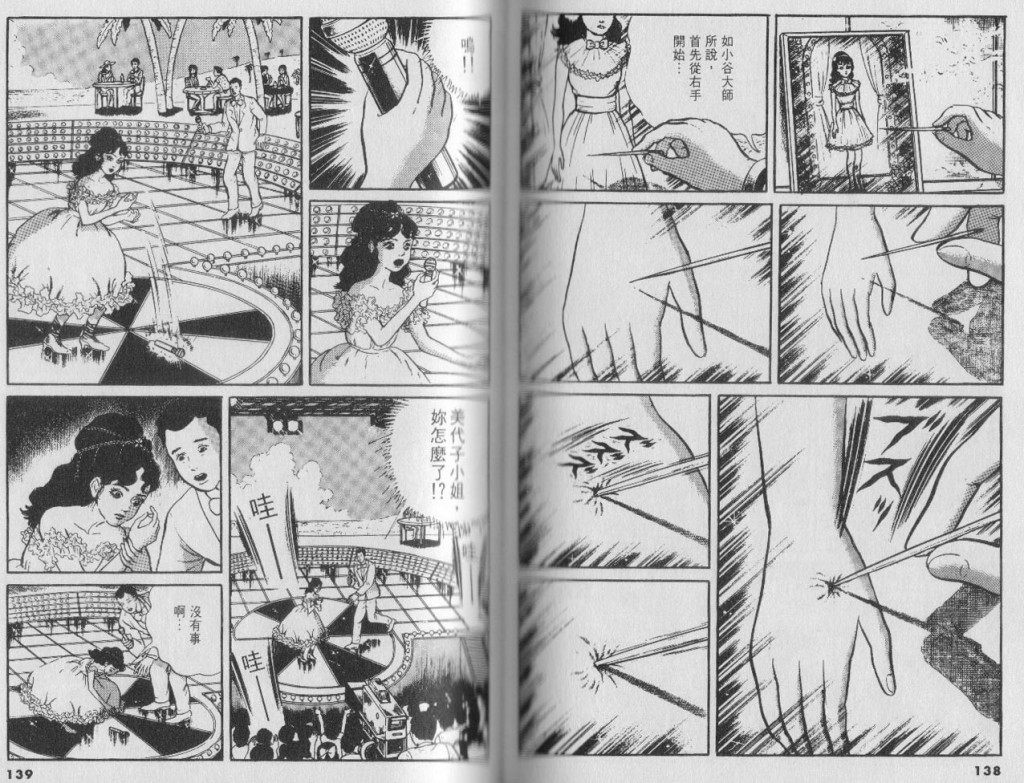

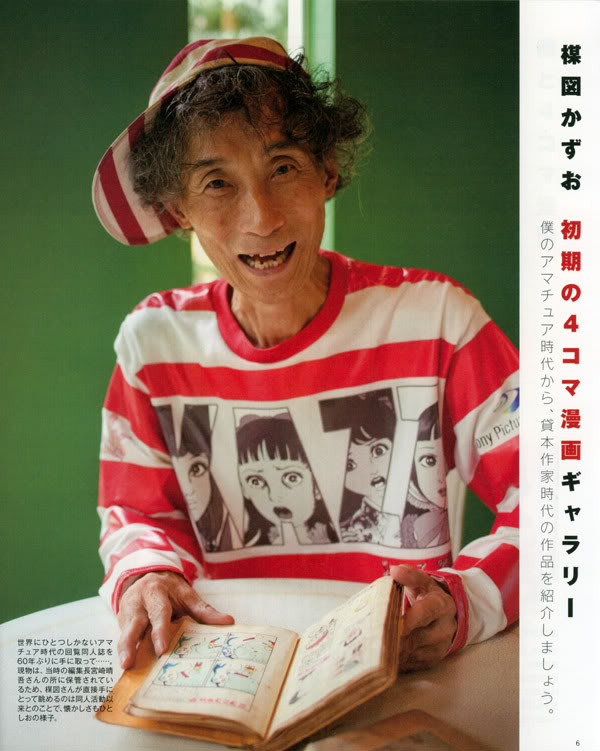
Damn. Where’s Dr. Wertham when you need him? Vile (if ably illustrated), degenerate stuff. That particularly helpless children are the targets in this torture-porn makes it even more noisome.
But then, this is the country where the murderer and devourer of a young woman can become a media celebrity:
——————–
A year after his release, Sagawa wrote the aforementioned book (now out of print) In The Fog in which he describes, in meticulous detail, the murder, rape, and consumption of Renee Hartevelt. This served to only fan the flames of his fame higher and higher. Eventually he found hiimself doing speaking gigs on various Japanese television shows, mainly guest spots on talk shows wanting to speak with the famed cannibal who ‘got away with it’. His fame doesn’t stop at eating women or writing about eating women, either. Sagawa, who is now 51, has taken up painting. Many of his paintings focus on women’s asses (no surprise there), but like all serial killer art, it has a fame that far outdistances its quality of production.
The Rolling Stones wrote a song about Sagawa, the aptly titled “Too Much Blood”. He has even appeared in several ‘pink movies’, Japanese soft-core porn with an artistic slant. By all accounts, Sagawa is a friendly, cheerful fellow who is more than willing to discuss his crime, especially when it puts money in his pocket. Recently, he’s even tried his hand at penning a manga re-telling of the murder…
———————–
http://www.weird-encyclopedia.com/Sagawa-Issei.php
It IS vile, gruesome stuff. But one thing that makes it different from the torture-porn genre and makes it more fascinating than disturbing is the fact that Kazuo Umezu gained his popularity by writing in comics magazine for young boys and girls (the writer clearly knows this from the disclaimer, but this fact is not told blatantly)
Yeah, those vile, degenerate, noisome…mangaka.
Thanks for posting these scans. Nothing I’ve read of Umezu’s (only in English, alas) has measured up to Drifting Classroom, but this looks like it could do it. I particularly like that unbelievably lurid injection sequence; Tom Neely, eat your heart out.
But what on earth is up with the harpooneer’s Janus-face??
Does it make it better or worse if you know that the assault by injection is done by a demon-possessed girl?
The harpooner is the hero of the tale and he’s sort of demon-possessed himself (hence the title of the manga). His wrathful aspects come into play towards the end of the series. You can’t help seeing shades of Umezu’s career in these dualistic characters (the low comedy of Makoto-chan vs the horror etc.).
As far as better Umezu Kazuo is concerned, I think “Orochi” and “Baptism” aren’t too bad if I remember correctly. I’m not particularly fond of “Fourteen” myself though that series has been recommended by Jason Thompson (?) in the pages of The Comics Journal. I think it’s still worth reading though.
———————
Ng Suat Tong says:
Does it make it better or worse if you know that the assault by injection is done by a demon-possessed girl?
———————-
…Would only make a difference if it had been Umezu who was demon-possessed!
Gleefully sadistic torture-porn; pedophiliac, too. “The evidence simply cannot be ignored.”
For whatever baffling reason, many people like looking at that sort of thing, delight in some skewered-woman’s eyeball movie scene, “Faces of Death” videos. Chacun à son goût, I guess…
*As a famed French necrophiliac said at his trial: http://tinyurl.com/3jbblxa .
Pingback: atlanticanime.com » Blue Exorcist and Dragon Ball rule!
Actually, I believe that “Left Hand of God, Right Hand of the Devil,” like “Fourteen” and My Name is Shingo,” was printed in Big Comic Spirits, a seinen magazine. So even by Japanese standards, this level of gore wasn’t exactly considered acceptable for children. Although Umezu would never have gotten into Spirits if he hadn’t made his fame in children’s magazines prior to that with similar but not-quite-as-explicit works.
Although I wrote about for TCJ it on the basis of just talking to Japanese friends and gaping at the pictures (mea culpa)… I have to admit, my opinion of “Fourteen” has actually gone down a bit as I’ve been able to read it in translation. It’s wildly imaginative, but it is SOOOO SLOWWW and so nonsensically unrealistic that it starts to push even my limits of patience. And the text is even more simplistic and childlike than in “The Drifting Classroom.” But it’s nice to see Umezu destroy the world.
Mike: With regards “demon-possession”, Umezu seems to imply as much if in a somewhat joking tone. Hence the self-portrait as a demon-possessed monkey in the final frame of the manga.
Jason is right. The Japanese Wiki does seem to indicate that the manga was published in Big Comic Spirits. I don’t know if “The Drifting Classroom” is that much kinder than “The Left Hand of God…” though (as Jason suggests as well).
“The Drifting Classroom” has the same feverish worldview as “Left Hand of God…”, and plenty of gruesome death, but I don’t think it has anything as graphic as some of the scenes in “Left Hand”, such as the crane death, the scissors-in-eyes, the scissors-in-anus… “Left Hand,” to me, feels very much inspired by the splatter movie craze of the ’80s. (And incidentally, another splatter fan, Hirohiko Araki, directly swipes the “bug imprinted on tongue” image in “Jojo’s Bizarre Adventure.”)